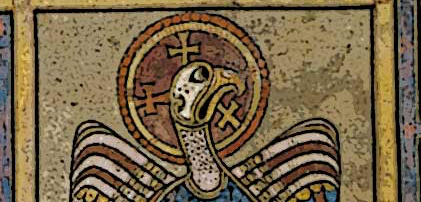A Cure for Sheep Disease
Written into the official documents of the Benedictine monastery of Eynsham in central Oxfordshire is a late 13-century ceremony for warding off sheep disease. After conducting a mass in honor of the Holy Spirit and making an offering, the priest gathers the sheep into a cote and performs a complex charm, commencing with a recitation from the beginning of Jn 1, In principio… (“In the beginning…”).
The occurrence of a text from John’s Gospel in a medieval charm against sheep murrain is not surprising. Even today, the Gospel of the Beloved Apostle is also one of the most beloved Gospels. People are drawn to its charming characters and colorful stories. Jesus’ teaching as presented in John is powerful and compelling. Yet the Gospel of John has seemingly always held a special fascination for its readers.
Long before monks settled in Eynsham, objects containing texts were revered as relics of mysterious power. Portions of scripture could serve as amulets and biblical codices were thought to manifest the divine presence in oath-swearing contexts and at ecumenical councils. Central to these uses is the materiality of the objects themselves, connected to but transcending the specific textual contents of the books.

Eagle symbol of John the Evangelist based on an image in the Book of Kells (Trinity College Dublin MS 58, f. 27v; ca. 800)
Although a variety of biblical texts and textual objects containing scripture were put to what may be called “bibliomantic” uses, the Gospel of John has held a special status in this regard, perhaps due to the mystical qualities of its language. For instance:
- Augustine of Hippo († 430) exhorts his hearers to cure their headaches by sleeping with a copy of the Gospel rather than using other amulets (In Joh. tr. 7.12).
- The smallest extant Latin biblical manuscript is the Chartres St. John, a tiny codex of John (71 x 51 mm) from the late 5th or early 6th century. It probably served as an amulet before it was put into the reliquary of the Virgin’s shirt at Chartres in the 11th century.
- The famous Stonyhurst Gospel is similar. Often described as the oldest intact European book, this diminutive Latin codex of John (138 x 92 mm) was apparently buried with St. Cuthbert (†687) when he was reinterred at Lindisfarne in 698.
These books containing John’s Gospel appear to have functioned as relics, material objects bearing special power.
The actual text of John was seen to be especially potent also. For instance, John’s opening statements of power feature prominently in early Coptic amulets with scriptural incipits. They were used apotropaically in Syriac healing charms and Arabic amulets. In the early 17th century, a certain sorcerer in Nottingham was known for selling copies of John’s Gospel for ten shillings apiece as protection against witchcraft.
Perhaps more than any other biblical book, the Gospel of John has been used in ways that reveal an enduring belief in its mystical power—including its role in practices of divination, the subject of another post.


Recent Comments